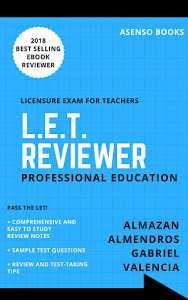The Licensure Exam for Teachers is one of the most important multiple-choice exams that you will take in your life. Your chances of passing the exam will depend, not only in your mastery of the subjects; Professional Education, General Education and your area of specialization, but also in your test-taking skills.
Multiple-choice exams are the most commonly used exam types of standardized test like the Teacher’s Board Exam. By learning the techniques in answering this type of assessment, you will increase the odds that you will get the right answer among the choices. It will also help you manage the exam to ensure that you will be able to answer all the questions within the given time period. Most importantly, this will give you a strategy in case you meet a question that you are unprepared for.
Rule 1: Learn how much time you have for each question
Each exam in the LET (Prof. Ed, Gen. Ed and Major Subject) has 150 items. However, you only have 2 hours for the first two (Prof. Ed and Gen. Ed) while you will have 2 hours and 30 minutes for your area of specialization (for Secondary Education takers only).
Knowing, this, you should be able to calculate the number of minutes you have for each question:
General Education and Professional Education: 48 seconds per question
Major Subject: 1 minute per question
Rule 2: Remember: Each item has the same weight
Each question in a multiple choice exam like the LET is worth one point, regardless of their difficulty level. The easy questions are just as important as the difficult ones. When answering the exam, make sure that you are able to read and answer all questions. This way, you will be able to answer all the easy questions even if they in the last numbers of the exam.

With this in mind, you may need to manage the amount of time that you are spending with each question. Here are some tips on how to do this:
Rule 3: Never leave an item blank
There are a number of reasons why you should never leave an item blank. Some say that blank items lead to erroneous readings by the test-checking machine. While I don’t subscribe to this belief, there is no harm in following this rule.
Before passing your answer sheet, check each number and make sure that you have shaded an answer for each question. If you have to guess, do it. Just don’t leave an answer blank.
Remember that leaving an item unanswered means that you are guaranteed one mistake. On the other hand, if you make a guess in a 4-option multiple choice question, you still have a 25% chance to guess the correct answer for that question.
Rule 4: Answer easy questions quickly

You will find some questions easy to answer. Answer them fast without being careless. Read the entire question and all the options, then pick the correct answer. The shorter the time you spend on these types of questions, the more time you will have left for more difficult ones.
Rule 5: Don’t be afraid to skip some questions
You will also encounter questions that will take you some time to answer. It’s not that you do not know the answer to these questions, but you may need to take some time to either analyze the question or solve the problem in your scratch paper.
The danger with these types of questions is that you may take too much time when answering them and you may not have time for the remaining questions.
To prevent this from happening, I suggest that you assess the questions first. If you can answer the question within the prescribed duration above, then you should answer the question. However, if you conclude that the particular question requires more than 48 seconds or a minute, you may want to skip it for now.

Before skipping any item, make sure that you take note of the number of the test question at the top part of your scratch paper. This will make it easier for you to go back to them later. After finishing the exam, that the time when you may go back to all the numbers you skipped. Hopefully, you will have enough time to answer all of the questions you skipped.
Rule 6: Create a Strategy for when you don’t know the answer
What will you do if you find a question you don’t know the answer to?
And, there will be questions that you will not have answers for. Hopefully, there will not be a lot of them. When I took the Licensure Exam for Teachers, I did not have a lot of study materials for the Filipino part of the General Education Exam. Needless to say, I was hoping that there would only be few question in that subject. In total, there was between 10-15 Filipino subject questions in the Gen Ed exam in my time.
For the easy Filipino subject questions, I dealt with them immediately (Rule 4). For the ones that I did not have answer for, I used rule number 5. I skipped them and returned to them after answering the rest of the exam. This way, I had more time to analyze each question.
Rule 7: Use some questions as clues for others
By skipping difficult questions, you will also have the opportunity to find clues about them in future items. Let’s say you skipped question number 10 and you took note of this in your scratch paper. When you arrived to question 25, you realize that its topic is related to question 10. You may want to take note of this in your scratch paper as well beside your note about question 10. This may assist you when making your educated guess when you return to the questions you skipped.
Rule 8: Use the process of elimination to increase your chance of getting the right answer.
You have four choices in an average licensure exam question. If you picked one of the choices in random, you will have a 25% chance to pick the correct answer in a 4-option multiple choice question. By eliminating the choices that you know are not correct, you will increase the odds of picking correctly. Let’s say that this is your question and you have no idea what the answer is:
Who is the author of the novel “Ang Kundiman ni Alice Brown”?
a. Jose Rizal b.Francisco Balagtas c. Diosdado Franco d. Ian Ignacio
By examining our choices, we see two familiar names, Jose Rizal and Francisco Balagtas. Both are writers in the time of the Spanish colonization of the Philippines. On the other hand, the title of the novel in the question is “Ang Kundiman ni Alice Brown”. The name of the woman in the question is a Western or American-sounding name. It’s may be safe to say that neither Balagtas nor Rizal would use such a name in the titles of their novel. With this reasoning, it may be safe to eliminate these from your choices when picking the correct answer. This means that you only have two choices left:
a. Jose Rizalb.Francisco Balagtasc. Diosdado Franco d. Ian Ignacio
Even if you just completely guess the answer, you now have a 50% chance to pick the correct answer.
Rule 9: Pay attention to Underlined and/or Bold words.
It is common for the people who prepare the board exam questions to underline important words in the question or to put them in bold.
Which of the following is NOT a prime number?
When you encounter questions like this, always be careful not to neglect this word. While this may seem like common sense, you will be surprised with the number of people who miss these markers in LET questions.
Rule 10: Picking AOTA and NOTA
You will also find a lot questions with “All of the Above” or “None of the Above” as the last option. You will need to analyze the question and the options when answering this type of question. Choose “All of the Above” only when you are sure that there are at least two correct answer. If you are not sure, skip them and use rules 5, 6, 7 and 8 above to answer it later.
Rule 11: Choose a go-to “Wild Guess” Letter
If you have to shoot in the dark, make sure that you do it intelligently. What I do is I pick one letter (usually the letter B). If I have no clue of the correct answer and I cannot use the process of elimination, I choose my go-to letter. I answer B to all my wild guesses.
This will increase the chance that you will get a correct answer among the items where you had to make a wild guess.

Ano pong possible na mangyari if meron kang na skip na item? huhu
Thank you for the tips.i will follow also the letter B if i dont know the answer..hope it will help me.,i will be taking the let this coming sept.25 2022.hope i can pass it..as a solo parent.